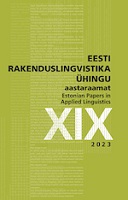Eesti vaatamisverbide sihilisusest
On the transitivity of Estonian watching-looking verbs
Author(s): Natalia VaissSubject(s): Syntax, Lexis, Semantics, Baltic Languages
Published by: Eesti Rakenduslingvistika Ühing (ERÜ)
Keywords: argument structure; transitivity; verb classes; polysemy; Estonian;
Summary/Abstract: The article studies the differences in the transitivity of Estonian watching-looking verbs. The aim is to determine their lexical semantic features that are related to the degree of transitivity, using the same corpus method. The analysis based on the Estonian National Corpus 2019 shows that Estonian watching-looking verbs vary in their degree of transitivity (i.e. the regularity of transitive and intransitive uses). According to the percentage of the transitive uses among 200 corpus sentences, the analyzed verbs can be divided into three categories (under 40%, 75–85%, and more than 90%). Most Estonian watching-looking verbs can be used with directional postpositions or other direction adverbials (e.g. to the left, down, into the future, etc.), but can also function without an object or a direction. The manner component reflected in the semantics of some Estonian watching-looking verbs can both promote and restrict the occurrence of the verb without an object or a direction. For all the verbs analysed, the occurrence without an object or a direction was syntactically favoured by the association of two or more actions, infinitive verb forms, the imperative, separative and sometimes also locative place adverbials, manner adverbials, and comparisons.
Journal: Eesti Rakenduslingvistika Ühingu aastaraamat
- Issue Year: 2023
- Issue No: 19
- Page Range: 245-266
- Page Count: 22
- Language: Estonian

